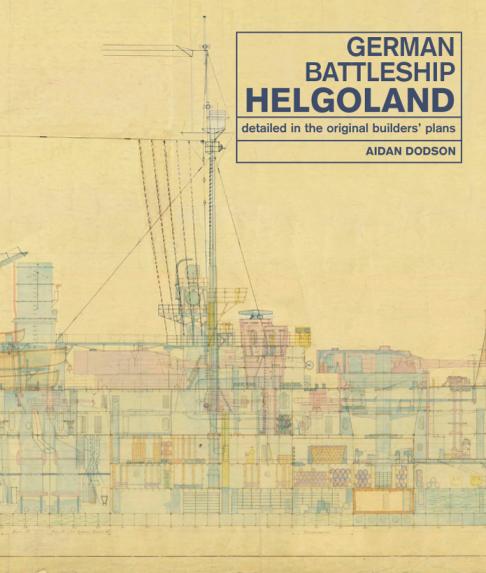
German Battleship Helgoland: Detailed in the Original Builders’ Plans. By Aidan Dodson. Seaforth Publications, Barnsley, 2019.
Reviewed by Gregory P. Gilbert
THE Imperial German battleship HELGOLAND was built by Howaldt in Kiel where she was launched in 1909 and completed in August 1911. She served throughout World War I, including at Jutland, and was surrendered along with the rest of the German High Sea Fleet in November 1918. Plans of HELGOLAND were also ceded to Britain as part of the peace treaty through the Naval Inter-Allied Commission. After extensive study by Royal Navy ship designers and operators, the plans were largely forgotten and finally made their way to the National Maritime Museum in Greenwich. Now it is our great fortune that Seaforth have published the HELGOLAND ship plans for all to peruse.
Initially the reader may be daunted by ship plans with German annotations, especially when they include German Gothic style script, however Aidan Dodson has provided comprehensive reference translations and sufficient background information to enable the reader to grasp the essentials quickly and effortlessly. It does not take long before the abbreviation ‘Kj.’ is recognised as ‘Koje’, meaning ‘Bunk’ in English. Dodson has done an excellent job in revealing the detail and explaining each plan. The standards of reproduction, once again, cannot be surpassed.
The remarkable thing is that many of the plans have material that is reasonable familiar to those who study warship plans. Although much is the same, there are a surprising number of differences between the design details of this German battleship and its British equivalents. This is perhaps one of the most interesting aspects of this book. It highlights the underlying cultural differences between the German and British warship philosophies.
Firstly the ‘hexagonal’ arrangement of main guns on HELGOLAND was decidedly less economic than the ‘inline’ or ‘wing turret’ arrangements of British and American early Dreadnought battleships. Despite being armed with twelve 12-inch (30.5cm) main guns, the HELGOLAND could only fire either a broadside of eight guns or a bow/stern shoot of six guns only. The German philosophy was to have unengaged turrets ready as a reserve during a firefight. This runs counter to the standard British and American practice of the time. The HELGOLAND also had a battery of fourteen 6-inch (15cm) secondary guns which also ran counter to the British practice.
One aspect of German battleship design that is often claimed is that they had reduced crew accommodation in their ships and hence the Germans suffered from reduced sea availability. Consideration of the accommodation in HELGOLAND, as revealed by the plans, shows that designers tended to allocate space to weapons, machinery spaces and officer cabins first and then place seamen’s messes with hammock stores in the remaining spaces. This is perhaps more of a cultural difference between the German and British naval design practice. The German ship accommodation represented the class divide between naval officers and sailors, although they did treat technical specialists the same as junior officers. The truth is that German sailors tended to live with their circumstances when at sea – the 1914 Pacific campaign confirms this. By 1918 after long periods in harbour with many German naval officers living ashore and their crews confined to limited mess areas – ship accommodation was indeed a contributory factor to the German Naval mutiny. It is perhaps fairer to suggest that the limited sortie times for Imperial German battleships had more to do with the bunk capacities and efficiencies of their triple expansion reciprocating engines than to sailor accommodation spaces.
It is also often stated that German battleships had superior damage control arrangements to their British equivalents during WWI. Examination of the HELGOLAND plans reveals the ship was extensively subdivided into watertight compartments each with its own parallel pumping system. In comparison the British battleships had fewer watertight compartments and operated a ring-main sea water systems for pumping and firefighting. The Germans reported that the number of watertight compartments on HELGOLAND class battleships was too excessive causing problems of access and/or isolation of damage. In effect there was a fundamental difference between the German – flee, isolate and defend – damage control philosophy, and the British – fight and recover – damage control philosophy. So, considering the evidence of the HELGOLAND plans, it is better to suggest that during WWI the German and British damage control philosophies were different but neither was any better than the other overall. These philosophical differences in warship designs truly represent the hidden cultural differences between the navies concerned.
This leads us to a moment of clarity. There have always been philosophical differences between the design philosophies of different navies. Warships themselves are the material products of the cultures that produce them. It is just as true today between warship designs, as it was during WWI between German and British battleship designs, or indeed as it was between American, Japanese and British aircraft carrier designs during WWII (a topic for another day!). So why does this matter? The Royal Australian Navy was formed and operated for over 50 years within the British Royal Navy cultural framework. The RAN then spent some time working alongside the US Navy culture. Today the RAN operates warships underpinned by a variety of different navy cultures outside Australia. We have anecdotal evidence of problems associated with the fundamental cultural differences between these supplier navies and the resultant impact on warship design, support and operation but we have yet to fully appreciate the significance. The 21st century RAN does not follow any single specific navy culture, nor does it yet have its own stand-alone Australian navy culture, and we remain largely blind to the consequences.
‘German Battleship’ Helgoland’ is another excellent book for anyone interested in maritime affairs. As with many of the books in this series it opens one’s eyes to much more than is visible on the original plans. It is hard to put down.



